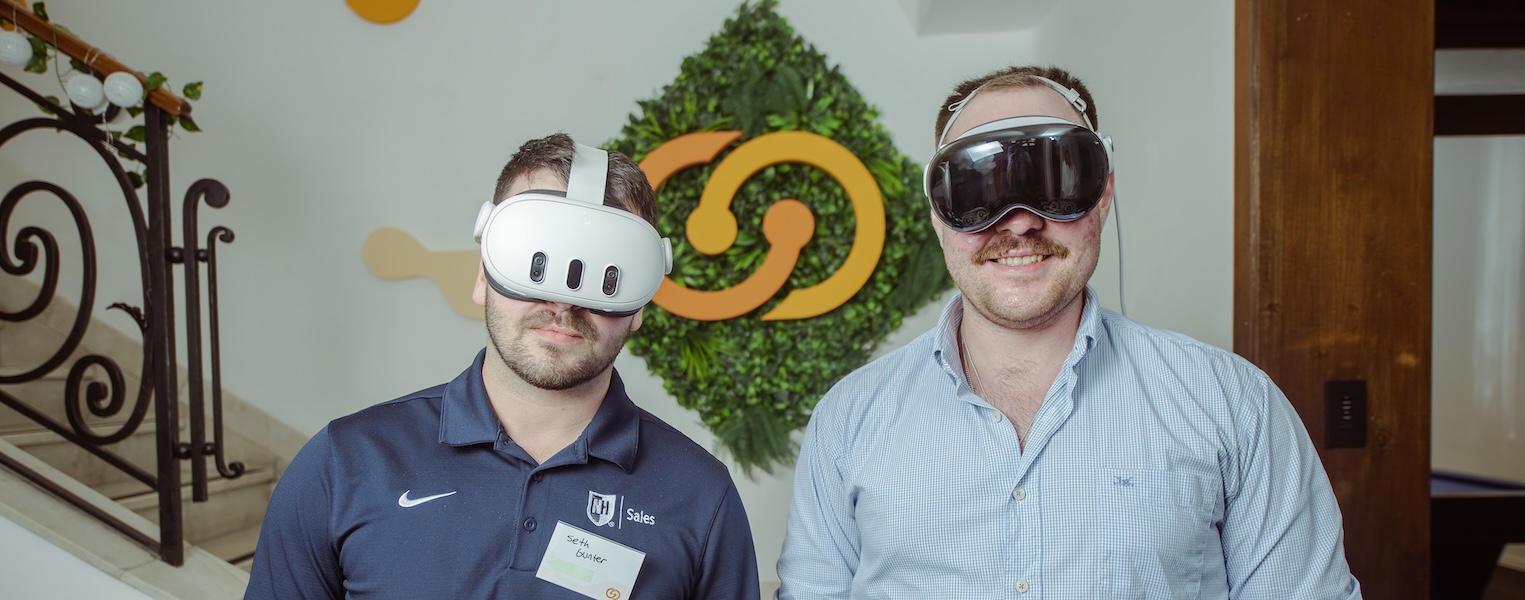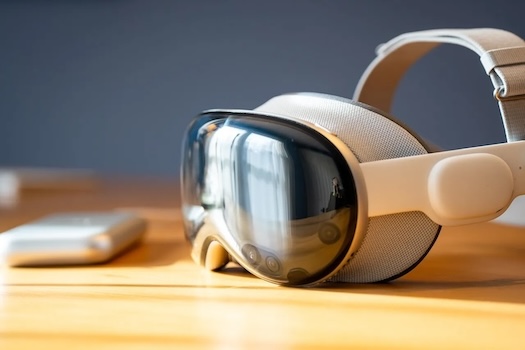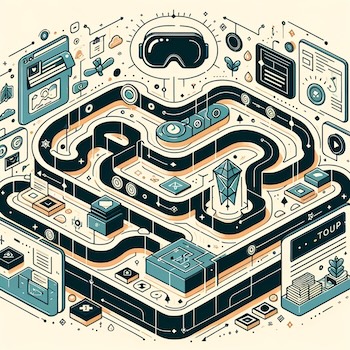
Introduction
In the constantly evolving world of technology, it’s fascinating to explore how our understanding and interaction with machines have grown, starting from the basic instincts of a child recognizing shapes, to the complex world of 3D computing we’re venturing into today. At OrangeLoops, we’re always excited to dive into these advancements and share our insights.
The Innate Understanding of Shapes and Intelligence in Nature

Source: DALL·E 3
From our earliest moments, humans display an inherent understanding of shapes – a square block belongs in a square hole. This simple realization signifies the beginning of our journey in recognizing and interacting with the world around us. Similarly, the animal kingdom is not far behind in showcasing intelligence. Consider how a dog skillfully catches a ball or how ravens in certain regions use cars to crack open nuts. These actions reveal a level of understanding and adaptation that parallels human ingenuity.
Steve Jobs: Visionary of the PC as a Cognitive Tool
Steve Jobs, a pioneer in the technological world, once likened the personal computer to a bicycle for the human mind. Inspired by a study on energy efficiency in movement, Jobs envisioned the computer as a tool to enhance human productivity and creativity. His insight foresaw the computer revolutionizing how we work, think, and collaborate.

Source: DALL·E 3
The Shift from 1D to 2D Computing
A pivotal moment in Jobs’ journey, and indeed in the history of computing, was his visit to Xerox’s Palo Alto Research Center. Here, he encountered the graphical user interface for the first time, marking the shift from text-based (1D) to graphical (2D) computing. This leap made computers more intuitive and accessible, setting the stage for the technology we use today, including smartphones and tablets.
Can Technology Bridge the Gap with the Animal World?
The intuitive nature of modern interfaces raises an intriguing question – could animals interact with technology in a meaningful way? Imagine a world where we could design apps for dogs with large touchscreens suited for their use. This concept isn’t just fanciful thinking but a real possibility that highlights the simplicity and intuitiveness of modern interfaces.

Source: DALL·E 3
The Dawn of 3D Computer-Human Interaction
As we look to the future, we’re on the brink of another revolutionary leap in technology – the move towards 3D computer-human interaction. Encompassing virtual reality (VR), augmented reality (AR), and mixed reality, this new era will transform how we perceive and interact with the digital world. Interestingly, this isn’t a new concept. The roots of VR can be traced back to the late 1960s, but only now are we seeing its potential to be fully realized.
3D Tech in Everyday Life
Imagine swiping through 3D representations of menu items at a restaurant or having a virtual path to your gate at an airport. 3D technology promises to enhance customer experiences, aid in language translation, and revolutionize education. It has the potential to foster the greatest generation of engineers, artists, and thinkers by providing immersive, interactive learning and creative environments.
The Global Impact of Emerging XR Technologies
As we navigate the ever-evolving landscape of technology, it’s clear that the full impact of XR (extended reality) technology on the global stage is still unfolding. At OrangeLoops, we keenly observe the current state of the art in XR and draw parallels to anticipate the direction we’re headed. Notably, the XR market, much like the mobile device sphere, is currently dominated by two major players: Apple and Android.
The Meta Quest Series: Leading the Charge in XR
 Meta, leveraging its prowess in Android-based systems, has established a strong foothold in the XR domain with its flagship products: the Quest 2 and Quest 3. The Quest 2 was a significant step in bringing VR to a broader consumer base. Its successor, the Quest 3, takes this further by offering a more impressive mixed reality (MR) experience with advanced features like Lidar for depth sensing and superior spatial reconstruction. While the Quest 3’s capabilities are substantial (such as allowing users to perform simple tasks like writing), it’s not without limitations, such as difficulty in reading texts on the phone or directly viewing a computer monitor. Despite these limitations and the challenges developers face in getting apps approved on the Meta Quest store, the platform remains a hub for exploring a wide range of content.
Meta, leveraging its prowess in Android-based systems, has established a strong foothold in the XR domain with its flagship products: the Quest 2 and Quest 3. The Quest 2 was a significant step in bringing VR to a broader consumer base. Its successor, the Quest 3, takes this further by offering a more impressive mixed reality (MR) experience with advanced features like Lidar for depth sensing and superior spatial reconstruction. While the Quest 3’s capabilities are substantial (such as allowing users to perform simple tasks like writing), it’s not without limitations, such as difficulty in reading texts on the phone or directly viewing a computer monitor. Despite these limitations and the challenges developers face in getting apps approved on the Meta Quest store, the platform remains a hub for exploring a wide range of content.
Apple’s Vision Pro: A New Contender
 Just days after the Quest 3’s announcement, Apple introduced the Vision Pro, which instantly became a meme. With a hefty price tag of $3,499, Apple’s strategy was not to focus on VR but rather on MR as its primary function under the new banner of “Spatial Computing.” This approach indicates a shift from creating a fully virtual environment to enhancing the real world with digital elements. The Vision Pro, likened to Apple’s Lisa personal computer of 1989, is targeted at business use and content development for future VisonOS products. Its steep price reflects its positioning as a tool for professional applications, where its adoption could significantly reduce training times and improve efficiency, as seen in industries that previously used Microsoft’s Hololens.
Just days after the Quest 3’s announcement, Apple introduced the Vision Pro, which instantly became a meme. With a hefty price tag of $3,499, Apple’s strategy was not to focus on VR but rather on MR as its primary function under the new banner of “Spatial Computing.” This approach indicates a shift from creating a fully virtual environment to enhancing the real world with digital elements. The Vision Pro, likened to Apple’s Lisa personal computer of 1989, is targeted at business use and content development for future VisonOS products. Its steep price reflects its positioning as a tool for professional applications, where its adoption could significantly reduce training times and improve efficiency, as seen in industries that previously used Microsoft’s Hololens.
- The term ‘Spatial Computing’ refers to a computing environment that uses space (physical and virtual) as an interface for interaction.
- Apple’s Worldwide Developers Conference returns June 10, 2024
Eyes and Hands: The Future of Interaction in XR
Both Meta and Apple acknowledge that the future of MR and AR will heavily rely on natural human interactions – primarily through our eyes and hands. The Vision Pro excels in this area with its combination of eye and hand tracking, offering an unparalleled interactive experience. Meanwhile, the Quest 3, lacking eye tracking, relies on hand controllers or hand tracking, necessitating more physical interaction.
Choosing the Right XR Device: Vision Pro vs Quest 3
For individuals venturing into XR for leisure, development, or just for fun, the Meta Quest 3 stands out as a cost-effective choice with its robust MR and VR capabilities, along with a well-established content base.
In contrast, the Vision Pro, with its higher fidelity and intuitive interactions, is more suited for businesses developing niche, industry-specific applications.

Source: DALL·E 3
Navigating the XR Development Landscape
Deciding the right platform for app development in XR depends on the intended audience and required features. Whether it’s a complex task requiring high-fidelity MR (like medical applications) or a more general consumer application (like mood-enhancing environments), the choice between the Quest 3 and Vision Pro hinges on these factors.
Is your app for a doctor or someone performing a complex task that requires a higher fidelity MR experience and a more intuitive interaction? Develop for the Vision Pro.
Is your app for the masses to allow them to mark their windows and replace the gloomy winter weather for a beautiful, sunny summer afternoon to help fight seasonal depression? Develop for the Quest 3.
Does your app rely on complex computer vision ML models to work? The Vision Pro, with an impressive Apple chipset, would be best.
Does your app not rely on any new or unique features not offered by conventional development methods? Quest 3 is best for its larger market and mature SDK.
If you are struggling to determine how to position yourself at the forefront of what will be the future of almost everything, you are not alone, and we are here to help.
OrangeLoops: Your Guide to XR Development
At OrangeLoops, we understand the complexities and opportunities within the burgeoning field of XR. With our expertise in building web and mobile applications, developing computer vision ML models, and creating engaging user interfaces, we can be your compass to navigate this new and exciting path.
If you’re looking to develop an app for the next dimension of computing or explore the possibilities of XR technology, contact us to see how we can collaborate and navigate this promising future together.

